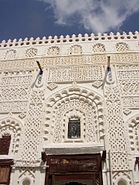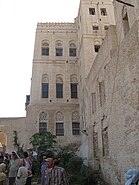Zubayd
| Zabid | |||||||
|---|---|---|---|---|---|---|---|
Clockwise from top:
Zabid skyline, Zabid Mosque, highrise building, architecture pattern, historic town |
|||||||
| Location in Yemen | |||||||
| Coordinates: 14°12′N 43°19′E / 14.200°N 43.317°E | |||||||
| Country |
|
||||||
| Governorate | Al Hudaydah Governorate | ||||||
| Time zone | Yemen Standard Time (UTC+3) | ||||||
| UNESCO World Heritage Site | |||||||
| Criteria | (ii), (iv), (vi) |
||||||
| Reference | 611 | ||||||
| Inscription | 1993 (17th Session) | ||||||
| Endangered | 2000– | ||||||
|
[]
|
|||||||
Zabid (Arabic: زبيد) (also spelled Zabīd and Zebid) is a town with an urban population of around 52,590 persons on Yemen's western coastal plain. It is one of the oldest towns in Yemen, and has been a UNESCO World Heritage Site since 1993; though, in 2000, the site was placed on the List of World Heritage in Danger.
The Great Mosque was built in 628 AD by Abu Musa Ashaari, one of the followers of Muhammad. The town was the capital of Yemen from the 13th to the 15th century.
The town, named after Wadi Zabid, the wadi (or valley) to its south, is one of the oldest towns in Yemen. Abu Musa Ashaari, one of the Prophet Muhammads companions, came originally from Zabid, and had the Great Mosque of the town built in 628 AD, also still during the Prophet's life. According to tradition, this is the 5th mosque built in the history of Islam. Zabid was the capital of Yemen from the 13th to the 15th century and a centre of the Arab and Muslim world due in large part to its famed University of Zabid and being a centre of Islamic education. It was the capital of the Ziyadid dynasty from 819–1018 and the Najahid dynasty from 1022–1158. Today, however, it is at the intellectual and economic margins of modern Yemen.
Zabid has an urban population of around 52,590 persons on Yemen's western coastal plain.
Zabid has been declared a World Heritage Site by UNESCO since 1993. Zabid's Great Mosque occupies a prominent place in the town. The vestiges of its university can also be visited.
...
Wikipedia






